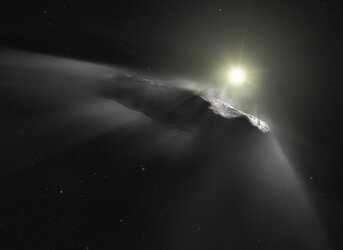Accept all cookies Accept only essential cookies See our Cookie Notice

About ESA
The European Space Agency (ESA) is Europe’s gateway to space. Its mission is to shape the development of Europe’s space capability and ensure that investment in space continues to deliver benefits to the citizens of Europe and the world.
Highlights
ESA - United space in Europe
This is ESA ESA facts Member States & Cooperating States Funding Director General Top management For Member State Delegations European vision European Space Policy ESA & EU Space Councils Responsibility & Sustainability Annual Report Calendar of meetings Corporate newsEstablishments & sites
ESA Headquarters ESA ESTEC ESA ESOC ESA ESRIN ESA EAC ESA ESAC Europe's Spaceport ESA ESEC ESA ECSAT Brussels Office Washington OfficeWorking with ESA
Business with ESA ESA Commercialisation Gateway Law at ESA Careers Cyber resilience at ESA IT at ESA Newsroom Partnerships Merchandising Licence Education Open Space Innovation Platform Integrity and Reporting Administrative Tribunal Health and SafetyMore about ESA
History ESA Historical Archives Exhibitions Publications Art & Culture ESA Merchandise Kids Diversity ESA Brand Centre ESA ChampionsLatest
Space in Member States
Find out more about space activities in our 23 Member States, and understand how ESA works together with their national agencies, institutions and organisations.
Science & Exploration
Exploring our Solar System and unlocking the secrets of the Universe
Go to topicAstronauts
Missions
Juice Euclid Webb Solar Orbiter BepiColombo Gaia ExoMars Cheops Exoplanet missions More missionsActivities
International Space Station Orion service module Gateway Concordia Caves & Pangaea BenefitsLatest
Space Safety
Protecting life and infrastructure on Earth and in orbit
Go to topicAsteroids
Asteroids and Planetary Defence Asteroid danger explained Flyeye telescope: asteroid detection Hera mission: asteroid deflection Near-Earth Object Coordination CentreSpace junk
About space debris Space debris by the numbers Space Environment Report In space refuelling, refurbishing and removingSafety from space
Clean Space ecodesign Zero Debris Technologies Space for Earth Supporting Sustainable DevelopmentLatest
Applications
Using space to benefit citizens and meet future challenges on Earth
Go to topicObserving the Earth
Observing the Earth Future EO Copernicus Meteorology Space for our climate Satellite missionsCommercialisation
ESA Commercialisation Gateway Open Space Innovation Platform Business Incubation ESA Space SolutionsLatest
Enabling & Support
Making space accessible and developing the technologies for the future
Go to topicBuilding missions
Space Engineering and Technology Test centre Laboratories Concurrent Design Facility Preparing for the future Shaping the Future Discovery and Preparation Advanced Concepts TeamSpace transportation
Space Transportation Ariane Vega Space Rider Future space transportation Boost! Europe's Spaceport Launches from Europe's Spaceport from 2012Latest

Soyuz VS16 transfer from MIK to launch zone
Thank you for liking
You have already liked this page, you can only like it once!
Soyuz VS16 was transferred from the preparation building MIK to the Soyuz launch zone of the Europe’s Spaceport in French Guiana, on 24 January 2017.
The vehicle was rolled out horizontally on its erector from the MIK to the launch zone and then raised into the vertical position.
Soyuz VS16 will lift off in the early hours of 28 January (CET). The rocket will carry Hispasat 36W-1 satellite which will be the first satellite to use the SmallGEO platform.
SmallGEO is a multipurpose satellite platform capable of accommodating a wide range of commercial telecommunications payloads and missions, from TV broadcasting to multimedia applications, Internet access and mobile or fixed services in a wide range of frequency bands.
Its new, modular and flexible design boosts European industry’s ability to play a significant role in commercial satcoms by easing entry into the lower-mass telecom satellite market. It was developed by Germany's OHB System AG under ESA's ARTES Advanced Research in Telecommunications Systems programme.
Hispasat's Hispasat 36W-1 will be the first satellite to use the SmallGEO platform, marking the first partnership between ESA and a Spanish operator. H36W-1 will provide Europe, the Canary Islands and South America with faster multimedia services through its Redsat payload, which offers better signal quality and flexible land coverage. Redsat enables H36W-1 to provide advanced connectivity services based on the latest communication standards.
-
CREDIT
ESA–Stephane Corvaja, 2017 -
LICENCE
ESA Standard Licence

Soyuz VS16 transfer from MIK to launch zone

Soyuz VS16 transfer from MIK to launch zone

Soyuz VS16 transfer from MIK to launch zone

Soyuz VS16 transfer from MIK to launch zone















 Germany
Germany
 Austria
Austria
 Belgium
Belgium
 Denmark
Denmark
 Spain
Spain
 Estonia
Estonia
 Finland
Finland
 France
France
 Greece
Greece
 Hungary
Hungary
 Ireland
Ireland
 Italy
Italy
 Luxembourg
Luxembourg
 Norway
Norway
 The Netherlands
The Netherlands
 Poland
Poland
 Portugal
Portugal
 Czechia
Czechia
 Romania
Romania
 United Kingdom
United Kingdom
 Slovenia
Slovenia
 Sweden
Sweden
 Switzerland
Switzerland
























